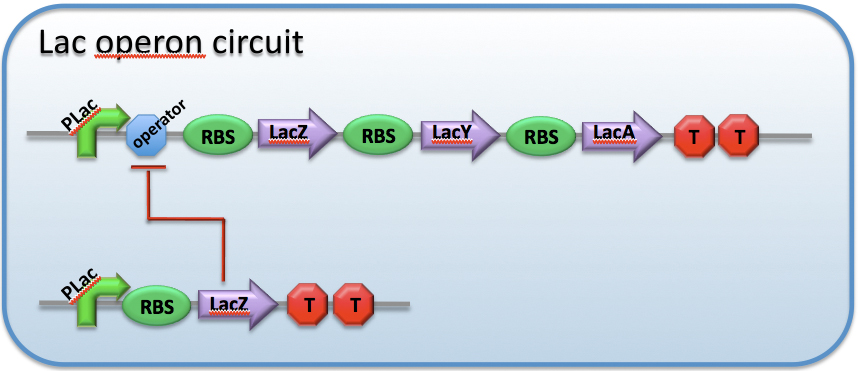Team:Imperial College London/Chemoinduction/LacOperon
From 2009.igem.org
(→Animated Explanation) |
(→Animated Explanation) |
||
| (3 intermediate revisions not shown) | |||
| Line 1: | Line 1: | ||
{{Imperial/09/TemplateTop}} | {{Imperial/09/TemplateTop}} | ||
| + | =The Lac operon= | ||
| + | ===What it is=== | ||
| + | [[Image:II09_LacOperon.png|710px]] | ||
| + | The lac operon is responsible for transport and metabolism of lactose in E-coli, and has the following architecture: | ||
| + | The <b>lacI</b> gene codes for the LacI protein, which inhibits transcription of the genes downstream by binding to the operator region (po). This inhibition is effective because the RNA polymerase is forced to drop off the DNA template when encountering a bound operator region. | ||
| + | <b>LacZ</b> encodes the enzyme β-galactosidase responsible for the degradation of β-galactosides. Since lactose is a β-galactoside, the enzyme will degrade lactose into galactose and glucose. This gene is sufficient to degrade lactose. | ||
| + | <b>LacY</b> encodes for a permease located to the outer membrane, thus ensuring the transport of lactose into the cell. This is a key element of the lactose operon as it acts as a feedback mechanism in the genetic circuitry. In fact, when lactose is present, it stimulates the production of large amounts of permease thus acting as positive feedback. | ||
| + | The LacA protein encodes β-galactoside transacetylase. The exact function of this protein in the lac system has not yet been determined. | ||
| - | ==Animated Explanation== | + | |
| + | ===Animated Explanation=== | ||
This animation by McGraw-Hill clearly explains the action of the famous Lac Operon. | This animation by McGraw-Hill clearly explains the action of the famous Lac Operon. | ||
| Line 7: | Line 16: | ||
<html> | <html> | ||
<center><embed src="http://highered.mcgraw-hill.com/olc/dl/120080/bio27.swf" quality="high" bgcolor="#000000" width="552" height="460" name="flashanimation" align="middle" allowScriptAccess="sameDomain" allowFullScreen="false" type="application/x-shockwave-flash" pluginspage="http://www.macromedia.com/go/getflashplayer" /></center> | <center><embed src="http://highered.mcgraw-hill.com/olc/dl/120080/bio27.swf" quality="high" bgcolor="#000000" width="552" height="460" name="flashanimation" align="middle" allowScriptAccess="sameDomain" allowFullScreen="false" type="application/x-shockwave-flash" pluginspage="http://www.macromedia.com/go/getflashplayer" /></center> | ||
| - | Source: <a href="http://highered.mcgraw-hill.com" target="_blank">McGraw-Hill</a></html> | + | <center> Source: <a href="http://highered.mcgraw-hill.com" target="_blank">McGraw-Hill</a></center></html> |
| + | |||
| + | |||
| + | |||
| + | <html><center><a href="https://2009.igem.org/Team:Imperial_College_London/Chemoinduction"><img width=150px src="https://static.igem.org/mediawiki/2009/1/10/II09_TourArrow.png"></a> | ||
| + | </html> | ||
{{Imperial/09/TemplateBottom}} | {{Imperial/09/TemplateBottom}} | ||
Latest revision as of 23:29, 19 October 2009

The Lac operon
What it is
 The lac operon is responsible for transport and metabolism of lactose in E-coli, and has the following architecture:
The lacI gene codes for the LacI protein, which inhibits transcription of the genes downstream by binding to the operator region (po). This inhibition is effective because the RNA polymerase is forced to drop off the DNA template when encountering a bound operator region.
LacZ encodes the enzyme β-galactosidase responsible for the degradation of β-galactosides. Since lactose is a β-galactoside, the enzyme will degrade lactose into galactose and glucose. This gene is sufficient to degrade lactose.
LacY encodes for a permease located to the outer membrane, thus ensuring the transport of lactose into the cell. This is a key element of the lactose operon as it acts as a feedback mechanism in the genetic circuitry. In fact, when lactose is present, it stimulates the production of large amounts of permease thus acting as positive feedback.
The LacA protein encodes β-galactoside transacetylase. The exact function of this protein in the lac system has not yet been determined.
The lac operon is responsible for transport and metabolism of lactose in E-coli, and has the following architecture:
The lacI gene codes for the LacI protein, which inhibits transcription of the genes downstream by binding to the operator region (po). This inhibition is effective because the RNA polymerase is forced to drop off the DNA template when encountering a bound operator region.
LacZ encodes the enzyme β-galactosidase responsible for the degradation of β-galactosides. Since lactose is a β-galactoside, the enzyme will degrade lactose into galactose and glucose. This gene is sufficient to degrade lactose.
LacY encodes for a permease located to the outer membrane, thus ensuring the transport of lactose into the cell. This is a key element of the lactose operon as it acts as a feedback mechanism in the genetic circuitry. In fact, when lactose is present, it stimulates the production of large amounts of permease thus acting as positive feedback.
The LacA protein encodes β-galactoside transacetylase. The exact function of this protein in the lac system has not yet been determined.
Animated Explanation
This animation by McGraw-Hill clearly explains the action of the famous Lac Operon.

 "
"



